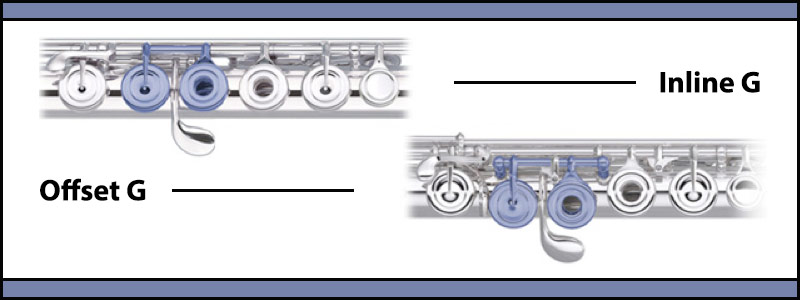
“Rather than automatically assuming that “offset G is for little kids” or “offset G is for lazy players,” try instead to think about the needs of the player and what will promote healthy playing.” – Dr. Rachel Haug Root
Searching for a new flute is an exhilarating experience, but it is often accompanied by feelings of uncertainty. Frequently, teachers give students extensive lists of features without explaining why they should seek out specific options, and one of the most common is the G key configuration. Choosing between inline or offset G leaves us wondering, “G(ee) – what’s the difference?”
To begin, let us define each option. The inline G key places both the G and the A key on a single rod next to each other. Many flutists, especially those with larger hands, prefer the hand position that the inline flute requires to play.
When French flutists like Georges Barrere and Marcel Moyse first came to North America in the late 19th and early 20th centuries, they brought with them inline G flutes. Because playing in the French style was all the rage, most flute players assimilated to this configuration and continued to play in a similar manner for much of the 20th century.
Today, many flutists prefer the comfort and hand position of the off-set G key. Having a separate rod for the G key means one less key on the A-Bb rod and, therefore, easier maintenance.
Young flutists learn to play on offset G flutes because this allows their smaller hands to more easily reach the G key. In truth, offset G flutists of all ages greater accessibility to the G key by following the natural alignment of the human hand. If we relax and rotate our left hand toward the little finger, we notice that the natural alignment of the ring finger does not fall in the same lines as the middle finger; rather, it is slightly offset. By more closely following the natural tendency of the body, the offset G affords comfort and practicality, often helping to alleviate such hand problems as carpal tunnel syndrome and tendinitis.
Because a growing majority of American flutists prefer offset G, many flute makers have begun making these instruments as their “standard” model; inline G is most commonly a special order. Rather than automatically assuming that “offset G is for little kids” or “offset G is for lazy players,” try instead to think about the needs of the player and what will promote healthy playing. Ultimately, it is important for flutists to try the instruments in order to find the right fit, but having a bit of information about the G key configuration will dramatically simplify the flute-finding adventure.
Contact your Schmitt Music store, or get in touch with the specialists at The Flute Gallery to learn more, or to set up your flute selection appointment. You can also visit Schmitt Music’s online Flute Gallery store – SHOP FLUTES now!
 Dr. Rachel E. Haug Root is a freelance flutist, orchestral musician, and private instructor in the Minneapolis area. In addition to her responsibilities as The Flute Gallery Manager, she maintains a private flute studio in the Twin Cities, and her students are frequently accepted to summer festivals and honors ensembles. Rachel also holds the position of Piccolo with the Mankato Symphony Orchestra and has performed with the La Crosse Symphony, Linden Hills Chamber Orchestra, John Philip Sousa First Memorial Band, Central Ohio Symphony, and the McConnell Arts Center Chamber Orchestra.
Dr. Rachel E. Haug Root is a freelance flutist, orchestral musician, and private instructor in the Minneapolis area. In addition to her responsibilities as The Flute Gallery Manager, she maintains a private flute studio in the Twin Cities, and her students are frequently accepted to summer festivals and honors ensembles. Rachel also holds the position of Piccolo with the Mankato Symphony Orchestra and has performed with the La Crosse Symphony, Linden Hills Chamber Orchestra, John Philip Sousa First Memorial Band, Central Ohio Symphony, and the McConnell Arts Center Chamber Orchestra.
Rachel earned her DMA and MM in flute performance from The Ohio State University, where she studied with Katherine Borst Jones, and BA from Luther College under the instruction of Dr. Carol Hester. Rachel’s research, An Introduction to Twentieth-Century Flute Music by Norwegian Composers: With Emphasis on Øistein Sommerfeldt and Publications by Norsk Musikforlag, seeks to broaden awareness of the available flute repertoire. During her time at Ohio State, Rachel served as principal flute in the Wind Symphony and Symphony Orchestra while also performing as a member of the Ohio State Fife and Drum Corps. Additionally, she assisted in planning the annual Central Ohio Flute Association Festival at Ohio State, serving as newsletter editor, exhibits coordinator, and president.
Rachel is the recipient of the OSU Graduate Achievement Award and past winner of the DMA concerto competition. She is featured on the Naxos recordings Network and Rest, and in the 2008 Emmy Award-winning production Christmas at Luther. She has toured with ensembles throughout the United States, Europe, and Japan.
